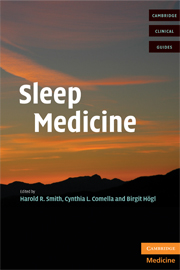Book contents
- Frontmatter
- Contents
- List of contributors
- Foreword
- SECTION 1 NORMAL SLEEP
- SECTION 2 SLEEP DISORDERS
- SECTION 3 SLEEP IN SPECIALTY AREAS
- 9 Sleep and neurologic disorders
- 10 Sleep and psychiatric disorders
- 11 Sleep and medical disorders
- 12 Sleep and pediatrics
- 13 Sleep and geriatrics
- 14 Forensic sleep medicine issues: violent parasomnias
- Index
- References
12 - Sleep and pediatrics
from SECTION 3 - SLEEP IN SPECIALTY AREAS
Published online by Cambridge University Press: 08 August 2009
- Frontmatter
- Contents
- List of contributors
- Foreword
- SECTION 1 NORMAL SLEEP
- SECTION 2 SLEEP DISORDERS
- SECTION 3 SLEEP IN SPECIALTY AREAS
- 9 Sleep and neurologic disorders
- 10 Sleep and psychiatric disorders
- 11 Sleep and medical disorders
- 12 Sleep and pediatrics
- 13 Sleep and geriatrics
- 14 Forensic sleep medicine issues: violent parasomnias
- Index
- References
Summary
Introduction
Sleep disorders are common health issues in childhood that are serious and treatable, but that often go undetected. The National Sleep Foundation's Sleep in America poll in 2004 found that as many as 69% of parents believe their child has a sleep problem, but over half of doctors do not ask parents about their child's sleep, and only 10–14% of parents raise the issue with their child's doctor. Chronic sleep problems constitute one of the most common sources of parent concerns and have a major negative impact on child and family functioning. Sleep affects every aspect of a child's physical, emotional, cognitive, and social development. Sleep problems exacerbate nearly any medical, psychiatric, developmental, or psychosocial problem in childhood. The aims of this chapter are to help clinicians understand developmental changes in sleep patterns, screen for and identify common pediatric sleep disorders, know what tests and treatments to consider, and decide when to refer to a specialist.
Prevalence
Insufficient sleep is the most common sleep disorder in both adults and children, affecting 10% of children and 33% of teenagers, with excessive television viewing, 24/7 lifestyles and bedroom electronics contributing to its high prevalence. Insufficient sleep has also been shown to be a risk factor for obesity in multiple epidemiological studies of children and adults. Table 12.1 summarizes the prevalence of common sleep disorders in children.
Keywords
- Type
- Chapter
- Information
- Sleep Medicine , pp. 208 - 223Publisher: Cambridge University PressPrint publication year: 2008

